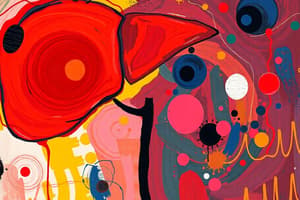Podcast
Questions and Answers
Which condition is indicated by the presence of bilirubin in the urine of a jaundiced patient?
Which condition is indicated by the presence of bilirubin in the urine of a jaundiced patient?
- Hepatocellular damage or hepatic obstruction (correct)
- Urinary tract infection
- Kidney failure
- Dehydration
What can be concluded from the presence of an orange brown color in urine upon standing?
What can be concluded from the presence of an orange brown color in urine upon standing?
- Excessive protein intake
- High glucose levels
- Conversion of urobilinogen to urobilin (correct)
- Presence of blood in urine
What method is used to detect bilirubinuria in urine?
What method is used to detect bilirubinuria in urine?
- Initial absorption on to insoluble barium salts (correct)
- Glucose testing strips
- Microscopic examination
- Urine pH testing
Which of the following is a likely cause of increased urobilinogen in urine?
Which of the following is a likely cause of increased urobilinogen in urine?
Under normal conditions, which of the following is not found in urine?
Under normal conditions, which of the following is not found in urine?
What does the presence of urobilinogen in urine typically indicate?
What does the presence of urobilinogen in urine typically indicate?
Flashcards are hidden until you start studying
Study Notes
Bilirubin and Urobilinogen
- In healthy individuals, bilirubin is not present in urine.
- Bilirubinuria in a jaundiced patient indicates jaundice is caused by conjugated bilirubin in plasma, which can be due to hepatocellular damage or hepatic obstruction.
Bilirubin
- Bilirubin produces visible changes, but sensitive tests may be required when visual examination is uncertain.
- Bilirubin can be detected by its concentration through initial absorption onto insoluble barium salts, formed by adding barium chloride to urine.
Urobilinogen
- Urobilinogen is colourless and not apparent on inspection unless converted to urobilin, which gives an orange-brown colour to urine.
- A small amount of urobilinogen is excreted normally in the urine of healthy individuals.
- Excess urobilinogenuria may occur during hemolysis of red cells, even if it's not sufficient to cause clinical jaundice.
- Excess urobilinogenuria may also occur in the pre-icteric stage of infective hepatitis and in diffuse liver disease, such as liver cirrhosis.
Studying That Suits You
Use AI to generate personalized quizzes and flashcards to suit your learning preferences.




